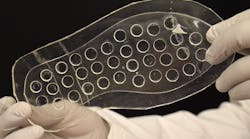Diabetes—specifically, the high blood sugar accompanying the condition—often damages nerves in the feet, leading sufferers to lose sensation. Without the ability to feel pain, scrapes and bumps go unnoticed, skin tissue breaks down, and ulcers form. To make matters worse, the excess sugar in the bloodstream, along with dried skin (another result of diabetes), slows the healing process.
As many as 15% of diabetics regularly develop ulcers, and about 20% of those lose toes, a foot, or a leg. The good news for them is that researchers at Purdue University researchers have developed a shoe insole that could help them heal faster without constraining them to a bed or chair.
“One of the ways to heal these wounds is by giving them oxygen,” says Babak Ziaie, an engineering professor at Purdue. “We’ve created a device that gradually releases oxygen throughout the day, so patients can have more mobility while receiving treatment.”
“We typically treat ulcers by removing dead tissue from the wound’s surface, and by helping the patient take the weight off the affected foot,” explains Desmond Bell, a podiatrist specializing in wound management and amputation prevention at Memorial Hospital in Jacksonville, Fla. “The gold standard for treating an ulcer is a patient wearing a total-contact cast, which provides a protective environment for the foot. If we could test how well this insole delivers oxygen to the wound site from within the cast, then this could be a way of aiding the healing process.”
Purdue researchers used lasers to turn silicone-based rubber into insoles, then creating reservoirs in the insole that release oxygen only where the ulcer is. Silicone is flexible and has good oxygen permeability, and laser machining tunes that permeability at the wound site which needs oxygen, rather than poisoning the rest of the foot with too much oxygen.
According to the team’s simulations, the insole delivers oxygen for at least eight hours under the pressure of someone weighing between 117-179 lb. But the insole can be tuned to take on any weight, the researchers say.
The team envisions a manufacturer sending a patient a pack of pre-filled insoles customized to his or her wound site, based on a “wound profile” obtained from a doctor’s prescription and an image of the foot—a form of low-cost mass-customization.
The researchers next goal is to 3D print the whole insole, rather than printing a mold first and laser-machining a pattern. They also want to test the insole on actual diabetic ulcers to gauge how well it accelerates healing.
A patent is pending on the insole technology and the research team is looking for corporate partners.

